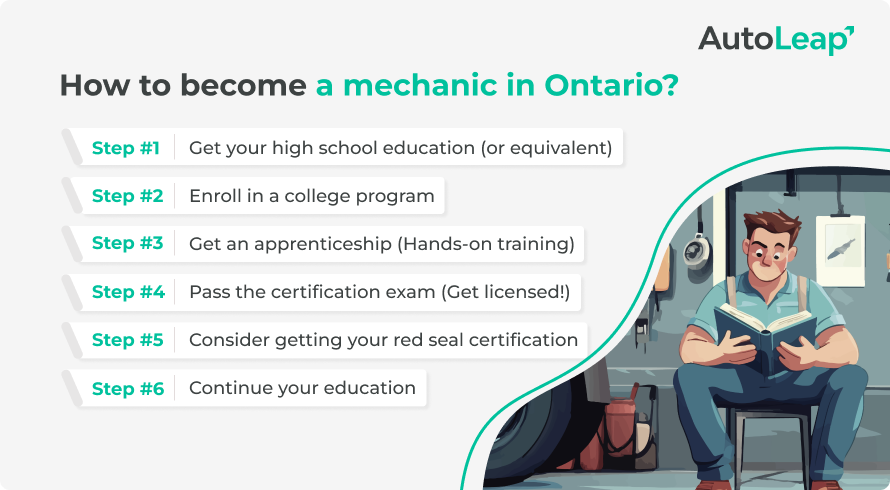Ever looked under the hood of a car and thought, “I’d love to do this for a living”? If you enjoy working with your hands, solving problems, and have a passion for cars, a career as an auto mechanic could be the perfect fit.
But how do you become a mechanic in Ontario, Canada? Since this is a regulated trade, there are specific steps and requirements you’ll need to meet before you can officially call yourself an automotive mechanic.
In this guide, we’ll break it all down—what skills you need, the training process, and how to get certified. Let’s dive in!
What does a mechanic do?
Mechanics don’t just fix cars—they keep them running safely and efficiently. Whether working on a family sedan, a motorcycle, or a commercial truck, mechanics inspect, diagnose, and repair various vehicle systems, including:
- Engines – Checking for leaks, replacing spark plugs, and repairing worn-out components.
- Transmissions – Ensuring smooth gear shifts and fixing transmission issues.
- Brakes – Inspecting brake pads, rotors, and fluid levels to keep vehicles stopping safely.
- Suspension and Steering – Checking alignment, shocks, and power steering systems.
- Exhaust Systems – Replacing mufflers, checking for leaks, and making sure emissions are in check.
- Electrical and Heating/Cooling Systems – Testing ignition systems, fixing air conditioning issues, and replacing faulty wiring.
Mechanics also use specialized diagnostic tools to identify hidden problems, communicate with parts suppliers, and keep detailed records of their work.
How to become a mechanic in Ontario?

Step 1: Get your high school education (or equivalent)
Before you jump into fixing cars, you need a solid foundation. In Ontario, having a high school diploma or equivalent (like a GED) is recommended. While it’s not always a strict requirement, it makes things a lot easier when applying for mechanic training programs.
Here’s what to focus on in high school:
- Math – You’ll need to understand measurements, angles, and basic calculations.
- Science (Physics & Chemistry) – Helps you understand how different car parts work.
- Computer skills – Modern cars rely on diagnostic software, so knowing your way around a computer is a big plus.
- Shop class or auto repair programs – If your school offers auto repair classes, take them! Hands-on experience is the best way to learn.
Step 2: Enroll in a college program
While some people learn on the job, getting formal training can give you a huge advantage. Many colleges and vocational schools in Ontario offer automotive service technician programs that cover everything from basic repairs to advanced diagnostics. These programs cover:
- Vehicle systems (electrical, fuel, power engines, brakes, etc.)
- Trade software and diagnostic tools
- Safety procedures in a repair shop
- Hands-on work on various types of vehicles
Some well-known schools include:
- Centennial College – Offers an Automotive Service Technician program.
- Humber College – Provides hands-on training with modern diagnostic tools.
- Fanshawe College – Has a highly-rated auto repair course.
These programs typically last one to two years and combine classroom learning with hands-on shop experience. By the time you graduate, you’ll have a strong understanding of car systems, electrical work, and mechanical repairs.
Step 3: Get an apprenticeship (Hands-on training)
Now comes the fun part—working in a real shop! In Ontario, to become a licensed mechanic, you must complete an automotive service technician apprenticeship. This means working under an experienced mechanic while getting paid.
Here’s how it works:
- Find an employer willing to take you on as an apprentice.
- Register for a Registered Training Agreement (RTA) with Skilled Trades Ontario.
- Gain 7,220 hours of experience (about four years), including:
- 720 hours of classroom instruction
- 6,500 hours of on-the-job training
- Learn essential skills like vehicle inspections, repairs, and diagnostics under an experienced mentor.
Here’s what you need to know about apprenticeships:
- They usually last four years.
- You’ll complete 6,500 hours of hands-on work.
- You’ll also have 720 hours of in-class training.
- Many auto shops hire apprentices, and places like TIRECRAFT offer apprenticeship programs.
- Networking is key—talk to shop owners, attend industry events, and don’t be afraid to ask for opportunities.
An apprenticeship allows you to learn on the job, work with real customers, and get comfortable with everything from engine repair to brakes and suspension.
Step 4: Pass the certification exam (Get licensed!)
After finishing your apprenticeship, you’ll need to pass the Automotive Service Technician Certification of Qualification Exam. This is required if you want to become a fully licensed mechanic in Ontario.
Here’s how to prepare for the exam:
- Review everything you learned during your apprenticeship.
- Take practice tests online.
- Brush up on electrical systems, engine performance, and safety procedures.
- Study Ontario’s vehicle repair regulations.
Once you pass, congrats! You’re now a licensed mechanic in Ontario.
Step 5: Consider getting your red seal certification
Want even more opportunities? The Red Seal Certification allows mechanics to work anywhere in Canada without needing additional licensing. If you think you might want to move provinces someday, getting this certification is a smart move.
To earn a Red Seal, you need to:
- Already have your Ontario mechanic license.
Pass the Red Seal exam, which tests your knowledge and skills. You’ll need to pass a 125-question multiple-choice exam covering:
- Diagnosing engine issues
- Repairing electrical and driveline systems
- Understanding modern vehicle technology
Check the Red Seal website for free study resources.
Step 6: Continue your education
Technology in the auto industry is always changing. Many mechanics take extra certifications in areas like:
- Collision repair – Learning how to fix vehicle body damage.
- Electric and hybrid vehicle repairs – Working with advanced battery systems.
- Damage analysis and estimating – Providing accurate repair cost estimates.
These certifications can help you advance your career and take on specialized roles.
What’s next? Getting a job or starting your own shop
With your license in hand, you’re ready to start your career! You can:
- Work at an auto repair shop or dealership.
- Specialize in areas like performance tuning or electric vehicles.
- Open your own auto repair business (if you’ve got an entrepreneurial spirit!).
Many mechanics start in shops and work their way up to owning their own businesses. The key is to keep learning, build relationships, and always deliver great service.
Essential skills for mechanics
- Dexterity: Mechanics handle small parts and tools, so steady hands and precision are essential.
- Proficiency with repair shop equipment: Shops are filled with specialized tools, including:
-
- Vehicle lifts
- Engine hoists
- Brake lathes
- Air compressors
- Ability to operate diagnostic tools: Modern cars rely heavily on computer systems. Mechanics must be able to use diagnostic software to identify issues and suggest repairs.
- Knowledge of electrical systems: With more hybrid and electric cars on the road, understanding battery technology, wiring, and electronic control systems is becoming more important.
- Understanding of modern shop management technology: Most modern repair shops have shifted towards automation by adopting systems like mechanic shop software. These tools can automate tasks like invoicing, payment processing, vehicle inspections, inventory management, and more.
Final thoughts
Becoming a mechanic in Ontario is a hands-on, rewarding career path that offers great job security and the chance to work with something you love—cars! Whether you want to work in a shop, specialize in a certain type of repair, or start your own business, the opportunities are endless.
The key is to start with the right training, get hands-on experience, and never stop learning. If you’re passionate about cars and love solving problems, this could be the perfect career for you!
FAQs
How long does it take to become a car mechanic in Ontario?
It typically takes about four to five years. This includes one to two years in school and about four years of apprenticeship training.
How much do mechanics make in Ontario?
Wages vary depending on experience, location, and specialty. On average, mechanics earn $25 to $35 per hour, with experienced professionals making even more.
How do I get my auto mechanic license in Ontario?
You need to:
- Complete a mechanic training program (or get equivalent experience).
- Finish a 6,500-hour apprenticeship.
- Pass the Ontario certification exam.
What education do you need to be a mechanic in Ontario?
While you don’t need a university degree, most mechanics complete a college program and an apprenticeship before becoming licensed.









